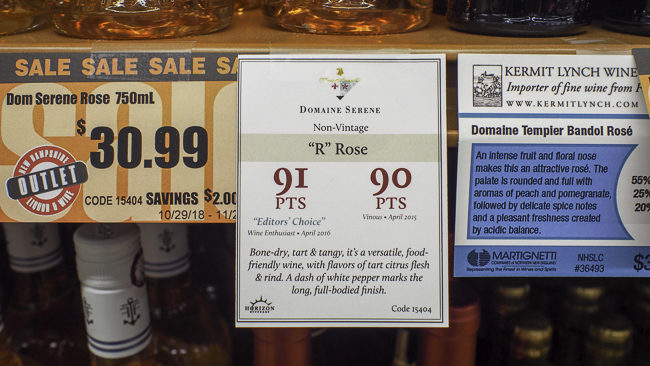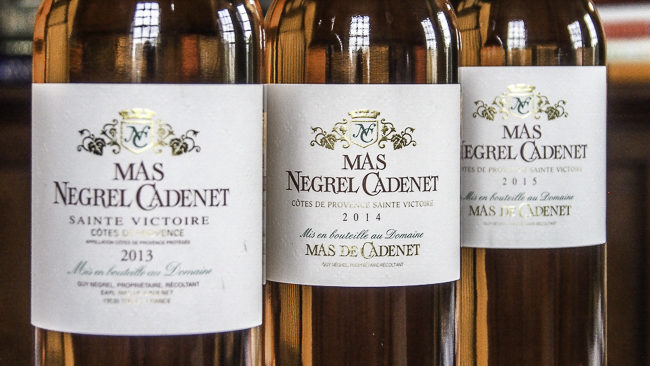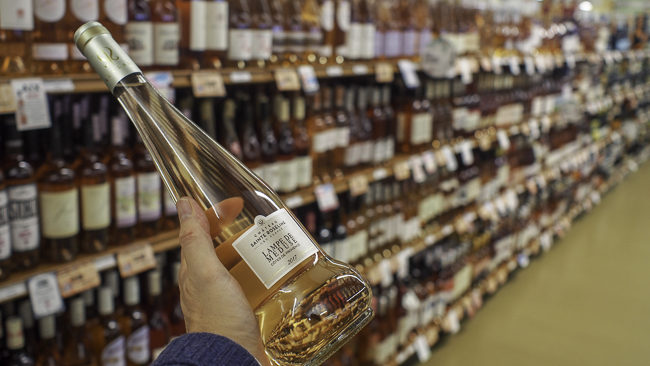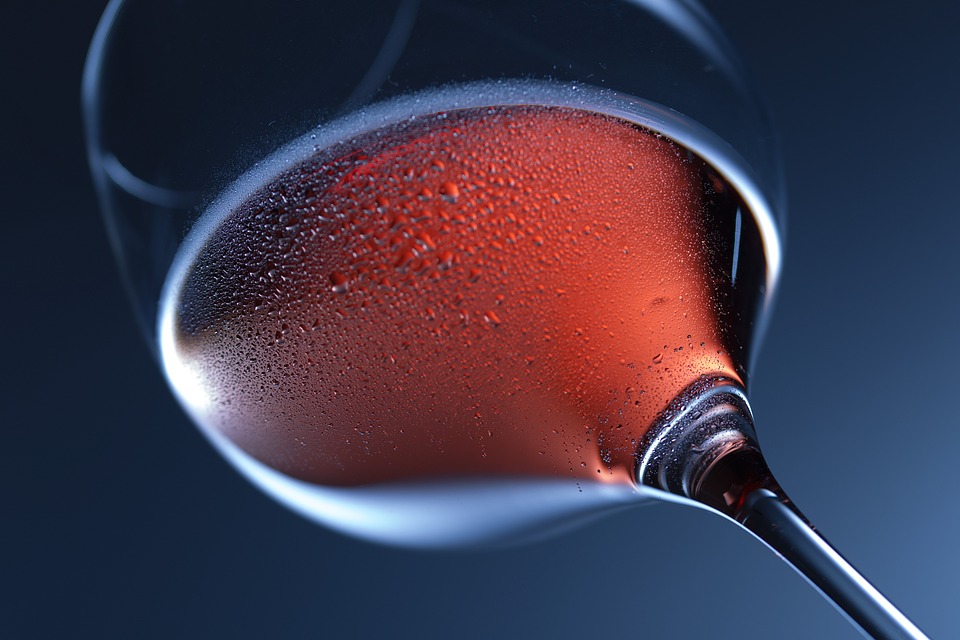Guest Blogger Jerry Clark. Musings of a Wine Maven was first published in Provence WineZine and published here by permission.
Numerous studies have been conducted in the food industry on what influences shoppers’ buying decisions. I came across several such studies during my printing equipment sales career, as print quality of the package can have enormous impact, positive or negative, at the moment of selection. What stands out in my mind today from those reports is that the shopper facing a broad choice of packaged food items might need only 10 seconds, even less, to make his or her decision. This brief time of study pondering a selection is known as “eye fixation duration” or simply “fixation length.”
Moving the consumer away from food and over to the wine department, the fixation length might go beyond 10 seconds as the price is considerably higher for a bottle of wine than a box of corn flakes. For empirical evidence on selection criteria in the wine industry, consider a thought-provoking (2016) report I found: “Preferences of American Wine Consumers,” by Sonoma State University professors Liz Thatch, MW and Kathryn Chang. In this paper, the authors present the 2016 results of the third annual survey about what, why and where we buy wine in America.
I was particularly interested the criteria consumers use in making a wine purchase decision. Consider the following 13 possible criteria:
- Price
- Brand
- Varietal
- Country
- Label
- Vintage
- Alcohol Level
- State
- Region (appellation)
- Medals
- Organic Wines
- Sustainable Wines
- Biodynamic Wines
Before I divulge how the above choices were ranked, I should note that the survey sampling included 1,081 American wine consumers, and they were allowed to note more than one criterion in their answers. Take a moment and make your own ranking of the above before continuing.
Here are the results, in the order of most to least checked off:
- Price – 80%
- Brand – 66%
- Varietal – 46%
- Country – 35%
- Region – 21%
- State – 19%
- Alcohol Level – 18%
Label – 18% - Vintage – 16%
- Organic Wines – 7%
- Medals – 6%
- Sustainable Wines – 4%
- Biodynamic Wines – 2%
Such a low ranking for “vintage” may not surprise you, but keep in mind that the study was covering any wine selection, not just rosé. Its ranking kind of amazed me given that, years ago when I started down the road to my personal discovery of wine, Bordeaux and Burgundy were the king and queen of the world so learning their vintage years of merit was mandatory if you did not want to look the fool in front of a clerk at Sherry-Lehmann. I could not tell you when Hannibal crossed the Alps with his elephants, or the date Wolfe’s army captured Quebec City and ended French rule in Canada, but I sure know that Château Mouton-Rothschild was elevated to elite Premier Cru Bordeaux status in 1973.

Domaine Serene’s R rosé from Oregon clearly showing “non-vintage” on shelf tag. Photo by W.T. Manfull
These results led me to wonder about whether this seeming ambivalence toward vintage permeates all wine buying today. Given the rate that rosé is flying off the shelves these days, I decided to conduct an informal survey focusing on the significance of vintage solely for rosé purchases.
Relying on wine industry connections on LinkedIn, I made my query simple in the hopes that it would more likely touch a nerve of interest. I just wanted to learn what my contacts thought of the significance of vintage when purchasing rosé wine, contrasted with price and brand.

Three vintages of Mas Negrel Cadenet rosé. Photo by W.T. Manfull
I targeted two distinct audiences, namely “career wine industry” people (Group A) and professionals who have not held jobs in a business related to wine, referred to as “Consumers” (Group B). (With the latter group I could not determine if they enjoyed wine simply by perusing their profile displayed on LinkedIn.)
My initial question, sent to about 350 people, was open-ended and read:
Given that for most drinkers rosé is an easy quaffing wine, is vintage really significant
with rosé, as it very much is with red and white wine?
In an effort to increase response rate, after about 40 responses to the open-ended question, I switched to a close-ended approach with two possible choices, and sent it to about 2000 people:
When purchasing a bottle of rosé, how important is the vintage shown on the label,
versus the price or brand identity?
a. Significant
b. Insignificant
Of the approximately 2000 people to whom I sent the multiple-choice inquiry, 209 people replied. (Having no idea if those I designated “Consumers” even liked wine, imagine my relief when 72, fully 34%, of the non-wine industry responses came back.) Although the overall response rate was just 10%, I believe that the results of the survey provide a clear message.
| Survey Results- The Role of Vintage When Purchasing Rosé | |||
| Significant | Insignificant | Total Responses | |
| GROUP A (Wine Industry) | 102 | 35 | 137 |
| GROUP B (Consumers) | 30 | 42 | 72 |
These results give credence to what I have long assumed: while vintage identification is clearly valued among respondents in the wine trade, consumers who responded (i.e., those not in the wine industry) do not appear to share this view. More than half (58%) of Group B indicated that rosé vintage is insignificant compared to price and brand although, with 42% taking note of vintage importance, such results give more credit to the role of vintage than I had anticipated. Frankly, in my mind, the bulk of in-store rosé selections were very quick “grab and go” decisions. Perhaps shelf-talkers and blossoming smart phone wine apps are getting more consideration than I had imagined. Bully for them.
In examining the many interesting responses from respondents in the wine industry to the initial survey question, I noted an “eye-opener” from a vintner in New Zealand. Seems the importance of aesthetics related to the design of his rosé label led him to only show the vintage date on the back label. I thought this was a fairly daring move on his part, so on the next visit to my local merchant I checked the rosé stock to see if this was an aberration unique to New Zealand. Of the 24 rosés on display, two had vintage dates on the back label alone, and both were from Provence. One was selling at $13 and the other $20. I brought the limited shelf-viewing time point back to the Kiwi, and he acknowledged that label and price outweigh display of the vintage on the main label. Perhaps we have the making of a trend here. Likely not, but I will pay more attention to vintage placement in the future.
Lastly, as one who looks at the blurbs on the back of book jackets when shopping, I will leave you with a handful of comments supporting rosé vintage importance coming in from survey respondents who make their living in the wine world:
Absolutely! Maybe even more so than other wines as most consumers want the freshest rosé they can get. -Vineyard CEO, California
For us I would say that vintage is just as important for rosé as any other varietal. Our rosés (we make 2) are both rosés of Pinot Noir, and especially in Oregon vintage variation is tremendous. -Vineyard CEO, Oregon
It’s an intriguing question. Personally, I’ve given too little consideration to vintage variation in rosé. I think most people treat rosé like their preferred non-vintage fizz, i.e. they are loyal and brand-focused but not critical: they want the consistency that allows them to maintain the same emotional/circumstantial attachment to the brand they first connected with. -Director of on-line wine shop, United Kingdom
I would say, as with all wines, it depends on the care and attention given to the production of the rosé in question. In my experience top houses like Rimauresq and Château d’Esclans do have vintage variations in their wines. This I do not see as a negative but as proof that these houses seek to show the best that their vineyards are able to produce year on year. -Sommelier, United Kingdom
Vintage will have some impact but given that rosé is typically harvested earlier in the season, vintage would likely have less impact than say on a later ripening varietal like Cabernet Sauvignon. I would expect vintage would have more of an impact in cooler regions, than in warmer regions as well. -Winemaker, California
Absolutely vintage is important. In fact, I believe there is a great “looking glass” to the vintage through the early presented wines. -Winemaker and owner, Virginia
I do believe that vintage can be important for rosé – aging is not easy for rosé, because it ages differently than white and reds and it can turn difficult for a consumer to taste an aged rosé. With the current global wine market, it is difficult to sell a complete vintage production of rosé during the following twelve months after the harvest, and so aged rosés will be very common. -Winegrower, Portugal
In my wine shop I find that rosé is becoming far more popular. I think for most of my customers, vintage is entirely irrelevant unless they are developing a keen interest in wines (we try to help all our customers to do this with frequent wine tasting events and chatting about the wines in general anyway). Some customers get it. For the major though it is completely irrelevant – red, white and rosé too. -Owner, wine merchant, United Kingdom
I must admit over the years I believe that rosé isn’t really given as much thought over by the general public, majority of restaurants I’ve been to, including where I currently work, haven’t and don’t really concentrate on the rosé section of the wine list! However, there are some beautiful examples of rosé out there in the world, I just don’t think that the majority of the general public would pay the kind of money for those vintage rosés, except perhaps vintage rosé champagne. -Sommelier, United Kingdom
For the consumer that is just looking for that refreshing beverage, vintage doesn’t matter too much. This would account for the largest percentage of rosé sales. In terms of quality, vintage variation will show itself in rosé, just as it does for white and red wine – alcohol, fruit expression, etc. You are going to see more of these wines at slightly higher price point (maybe above $15 plus a bottle – I am talking off the top of my head here – but if I am paying $30 or more for a rosé, I anticipate seeing a wine that shows its vintage. If I am paying $10, I don’t anticipate seeing as much of the vintage showing forth in a rosé). -Sales representative, importer/distributor, Washington
Vintage is significant in the final outcome. Our rosé is a blend of Bordeaux varieties. Depending on the vintage the percentages can vary greatly. -Winery owner, Virginia
Our rosé was made to be a rosé. We harvested the clone 115 Pinot Noir grapes for the sole purpose of making rosé. Rosé should be low in alcohol. That is another key factor. Many who have become loyal customers of our rosé are those that prefer a rosé from Provence. -Vineyard owner, California
I would say that you are probably right in your thinking—at least in California. To achieve the average fruity rosé isn’t that difficult in any given vintage compared with trying to achieve complexity in a Cabernet or Chardonnay. -Winemaker, California
Not as much of an impact for years with excessive heat – where berries will be under ripe, or years with excessive wind from the Mistral of Tramontane. You are correct in stating that rosé is a drink now wine, generally kept for two years at the most. With the two conditions I mentioned the rosé will have less fruitiness and more bitter notes (referring to southern France). -Sommelier, Canada
It’s definitely being consumed more than it was 5 years ago. And Sommeliers are championing it as an all-year wine. Some are super light and will not last more than a year, but I’ve had some from the 80’s (Terrebrune 1983, Bandol) that were stunning. It really depends on how they’re made – as an afterthought or like a real wine? -Founder, beverage solution consultancy, New York
Most is a general term regarding “easy quaffing wine” but some rosés are pretty serious and very quality-driven like the ones from Provence for example, and, yes, vintage is just as equally important as it would be for reds and whites. Maintaining and achieving great aromatics, ripeness levels while retaining acidity is very important. -Enologist, wine group, California
Until very recently I would have said insignificant. But I have had some bad 2017 Sonoma rose recently – probably a result of the fires. -Wine Valuation and Appraisal Consultant, California
Significant: anything older than a year is perceivably tired. -Master of Wine, Asia
I rate it significant, but in Hong Kong it would depend a lot on the education of the consumer. -Brand Marketing Manager – Luxury, Wine and Tourism, Asia
Insignificant for me, but location is the thing – Provence, or south of France is my preference. -Food, Wine and Travel Writer, California
I would rate the vintage, in this context, as insignificant relative to price and brand identity. This is an exception of sorts compared to many French wines, particularly the glamorous appellations. -Master of Wine, New York
The fresher the better. For wineries the rose revolution has been a godsend. It has the distinct aroma of cash flow. -VP Sales, Distributor, California
Wow, great question…I probably rate in this order: 1) Producer 2) Appellation 3) Vintage…within reason…I’m not afraid of a 2015 or 2016 (current vintage is 2017) but 2010? Or 2011? I might push away from that. -President, Importer, Rhode Island
As a rosé consumer, I don’t give vintage any attention. My belief is that rosé is a youthful wine, driven by occasion rather than collection. As a producer of rosé in Texas (we are direct-to-consumer through our tasting room and club/allocation sales), vintage date is much less significant than brand, or price. Vintage variability is more significant for red and white. In fact, many wonderful rosés are born in “poor vintages” so if anything there may very be an inverse relationship. -Winery owner, Texas
I would say significant, since it is best to consume a young rose wine because of the oxidation process that occurs when it ages. -Fermentation Research Engineer, France
Significant, but not for the reason you might think. I have no qualms about buying and drinking last years’ rosé. In fact, it is always cheaper as well. The factors that help guide my decision are a) is the rosé high acid or at least from a producer/region known for high acid and b) is it holding its color. I find these rosés interesting and nuanced and slightly discounted over the current vintage. We all do it with champagne, right? Why not rosé? -Controller, Wine Group, California
Vital. Branding of much rosé sadly or perhaps not sadly is an influencer rather than a indicator of quality. Due to the delicate nature of “most” rosé, its ability to age does not match red or many white wines and therefore vintage is vital information for me. -Master of Wine, United Kingdom
For me, vintage is important (as important as brand, region, variety and price) …not in terms of was a given vintage particularly good or bad year but is the wine likely to still exhibit fruit attributes or more developed characters. -Professor of Enology, Australia

Photo by W.T. Manfull
Guest Blogger Jerry Clark. First published in Provence WineZine

